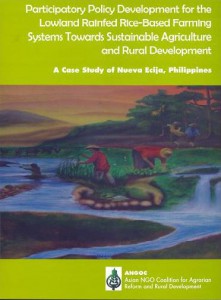Policy Development for Lowland Rainfed Rice
After fifty years, farmers in lowland, rainfed areas in the Philippines remain impoverished. Many of these lands remain unirrigated and underdeveloped. Both the farmer population and agricultural lands are facing extinction with such low economic returns offered by farming. The farmer either gives up tilling the land completely or sells his land to prospectors. Outmigration to the urban areas or even abroad, mostly by women, has become the best way out of this vicious cycle of poverty. This gives a general picture of the findings of this study on lowland rainfed rice-based farming system. Nueva Ecija was selected given its long rice-farming history to cover the timespan of the study. The study ran for almost two years from 2003 to 2004. ANGOC conducted this study, with the support of the Food and Agriculture Organization (FAO), to strengthen its call that sustainable agriculture is the viable alternative for resource poor farmers. Although the results of the study depict a disturbing scenario, we at ANGOC believe this is a powerful tool in urging governments to step up its support for such neglected areas in Philippine agriculture. The study also helps us present how sustainable agriculture is the best hope for the farmer in a lowland rainfed area with lower costs of inputs needed to sustain farming activities and better yield in time. This study is part of the process of ensuring the relevance and effectiveness of ANGOC’s work. It is intended to provide recommendations on how ANGOC can help call for the improvement of policy and programs in support of the small impoverished farmer.

